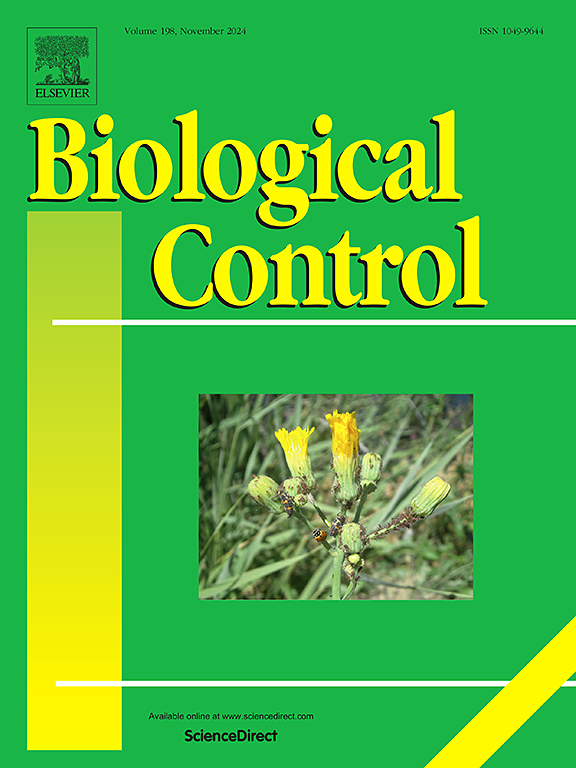黄颡鱼(膜翅目:姬蜂科)的生活史属性受营养和温度的调控
IF 3.4
2区 农林科学
Q2 BIOTECHNOLOGY & APPLIED MICROBIOLOGY
引用次数: 0
摘要
小偃麦草(astatus japonicus Ashmead)是半翅目:偃麦草科(Halyomorpha halys stastal)的有效卵寄生物。在自然界中,类寄生虫往往依赖生物和非生物因素,如补充营养来源(如糖)和最佳温度,以最大限度地延长其预期寿命和生殖潜力。我们的田间释放试验显示,日本刺参对halys的效果有限,可能是由于释放期间营养资源不理想和环境热条件不适当。因此,本研究旨在了解14种不同天然存在的糖和不同温度处理对日本刺参生命属性的影响。饲喂1 M水苏糖溶液的雄性和雌性的寿命相对较长,而饲喂麦芽糖、葡萄糖和果糖的雄性和雌性的总子代数和比例相对较高。低温(15°C)和高温(35°C)条件下,柽柳雄性和雌性后代的寿命和发育时间分别显著延长和缩短。喂食麦芽糖和水的雌性发育时间较长,而喂食糖糖的雌性发育时间较短。与三糖和四糖相比,柽柳对单糖和二糖的吸收效果更好。20 ~ 25℃是最适宜的群体饲养温度范围。我们认为,在恶劣的环境条件下,通过种植荞麦条,提供充足的麦芽糖、葡萄糖和果糖,并为日本野田鼠提供庇护,可以提高田间释放效果。本研究为日本稻螟对大褐家蝇的淹没生物防治提供了选择饲料添加剂和最佳饲养温度的机会。本文章由计算机程序翻译,如有差异,请以英文原文为准。

Life history attributes of Anastatus japonicus (Hymenoptera: Eupelmidae) are regulated by nutrition and temperature
Anastatus japonicus Ashmead (Hymenoptera: Eupelmidae) is an effective egg parasitoid of Halyomorpha halys Stål (Hemiptera: Pentatomidae). In nature, parasitoids often depend on biotic and abiotic factors such as supplementary nutritional sources (e.g. sugars) and optimum temperature to maximize their life-expectancy and reproductive potential. Our field release trials of A. japonicus against H. halys showed limited efficacy, potentially due to suboptimal nutritional resources and inappropriate ambient thermal conditions during the release period. Thus, the present study aims to understand the impact of 14 distinct naturally occurring sugars and different temperature treatments with respect to their effects on A. japonicus life attributes. Longevity of A. japonicus males and females fed with 1 M stachyose sugar solution was comparatively longer while numbers of total progeny and females’ proportion were relatively highest with provision of maltose, glucose or fructose, respectively. Anastatus japonicus male and female progeny had significantly lengthier and shorter longevity and development time at low (15 °C) and high temperatures (35 °C), respectively. Female development time were found to be longer when fed maltose and water, while shorter with melibiose. Anastatus japonicus performs better on mono- and di- saccharide sugars compared to tri- and tetra- saccharides. In addition, 20–25 °C is the most suitable temperature range to optimize mass rearing. We are assuming that field release efficacy could be improved by planting buckwheat strips providing adequate amounts of maltose, glucose and fructose alongside shelter for A. japonicus in unfavorable harsh environmental conditions. This study opens up opportunities to select food supplements and optimum rearing temperature for inundative biocontrol by using A. japonicus against H. halys.
求助全文
通过发布文献求助,成功后即可免费获取论文全文。
去求助
来源期刊

Biological Control
生物-昆虫学
CiteScore
7.40
自引率
7.10%
发文量
220
审稿时长
63 days
期刊介绍:
Biological control is an environmentally sound and effective means of reducing or mitigating pests and pest effects through the use of natural enemies. The aim of Biological Control is to promote this science and technology through publication of original research articles and reviews of research and theory. The journal devotes a section to reports on biotechnologies dealing with the elucidation and use of genes or gene products for the enhancement of biological control agents.
The journal encompasses biological control of viral, microbial, nematode, insect, mite, weed, and vertebrate pests in agriculture, aquatic, forest, natural resource, stored product, and urban environments. Biological control of arthropod pests of human and domestic animals is also included. Ecological, molecular, and biotechnological approaches to the understanding of biological control are welcome.
 求助内容:
求助内容: 应助结果提醒方式:
应助结果提醒方式:


